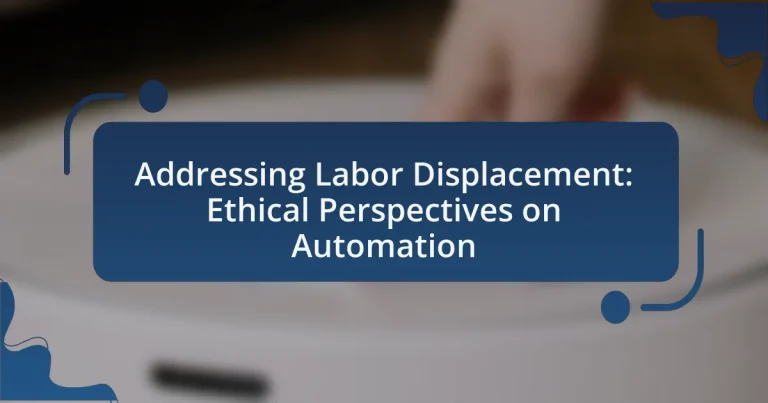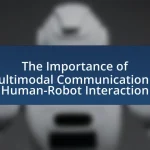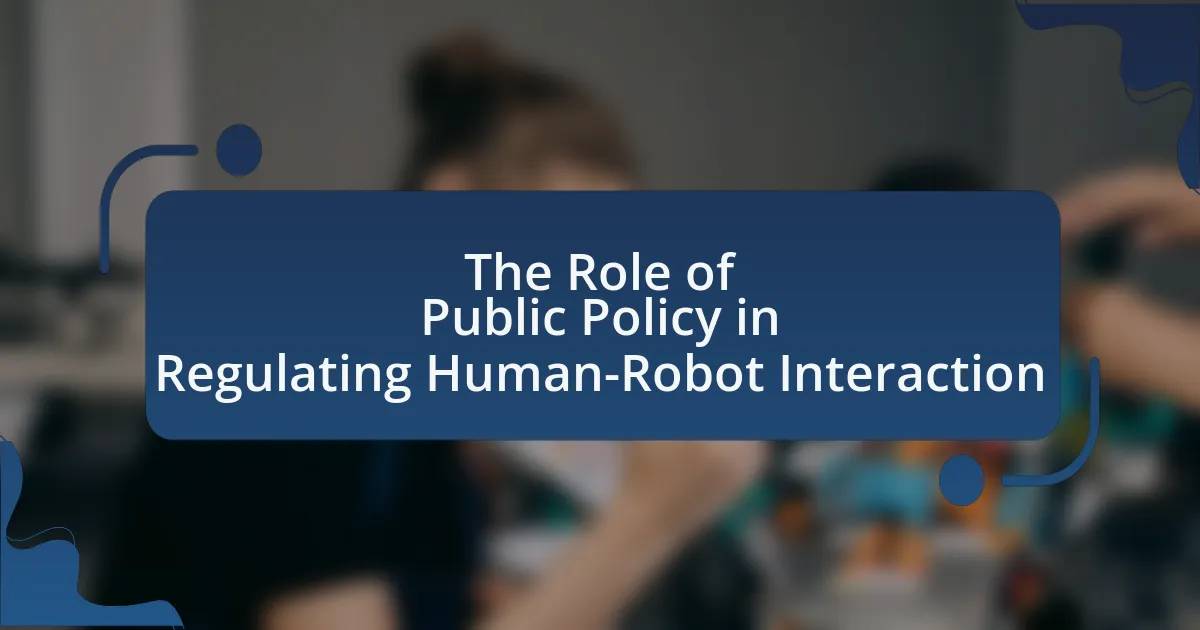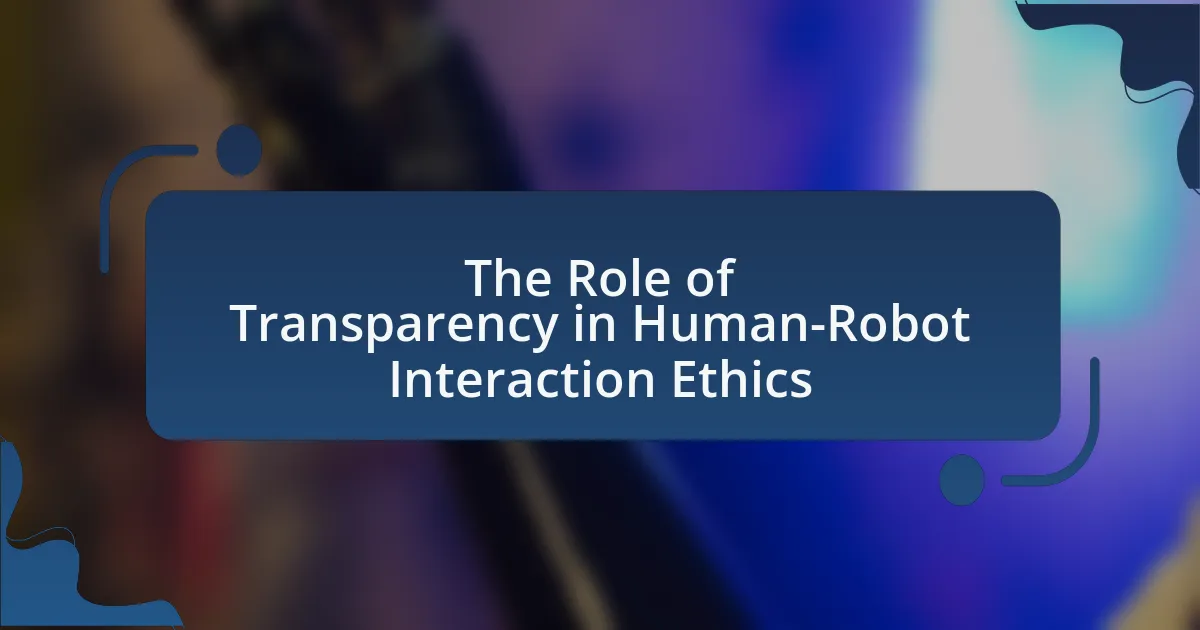Labor displacement refers to the loss of jobs due to automation, where machines and software replace human workers in various industries. The article examines the implications of this phenomenon, highlighting the potential displacement of up to 800 million workers globally by 2030, particularly in sectors like manufacturing, retail, and transportation. It discusses the economic and social consequences of labor displacement, including increased unemployment and income inequality, and emphasizes the importance of addressing these issues through retraining programs, social safety nets, and ethical corporate practices. Additionally, the article explores different ethical perspectives on automation, including utilitarianism, deontological ethics, and virtue ethics, and outlines strategies for businesses and governments to mitigate the impact of labor displacement on workers.
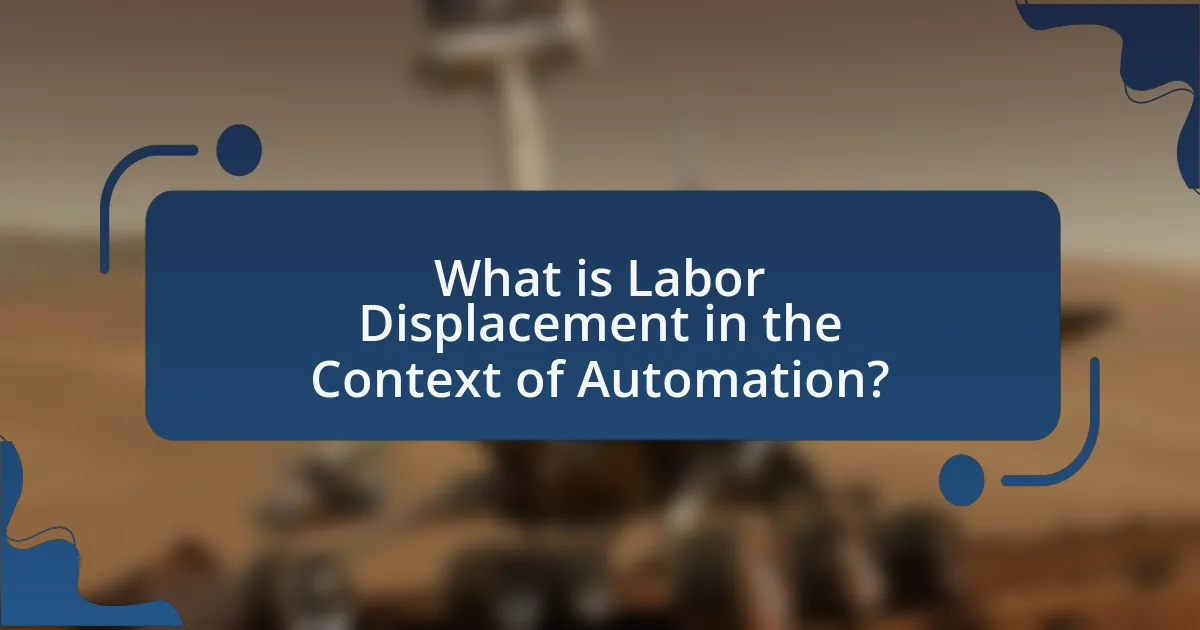
What is Labor Displacement in the Context of Automation?
Labor displacement in the context of automation refers to the phenomenon where workers lose their jobs due to the implementation of automated technologies that perform tasks previously done by humans. This displacement occurs as machines and software systems increasingly take over roles in various industries, leading to a reduction in the demand for human labor. For instance, a report by the McKinsey Global Institute estimates that by 2030, up to 375 million workers globally may need to switch occupational categories due to automation. This statistic underscores the significant impact of automation on employment and highlights the urgent need for strategies to address the resulting labor displacement.
How does automation contribute to labor displacement?
Automation contributes to labor displacement by replacing human workers with machines and software that can perform tasks more efficiently and at a lower cost. For instance, in manufacturing, the introduction of robotics has led to significant reductions in the need for manual labor; a report from the McKinsey Global Institute indicates that up to 800 million global workers could be displaced by automation by 2030. This shift occurs as businesses seek to enhance productivity and reduce labor costs, leading to job losses in sectors such as retail, transportation, and customer service, where automated systems can handle tasks traditionally performed by humans.
What types of jobs are most affected by automation?
Jobs most affected by automation include those in manufacturing, retail, and transportation. These sectors often involve repetitive tasks that can be easily performed by machines or software. For instance, a report by McKinsey Global Institute estimates that up to 800 million global workers could be displaced by automation by 2030, particularly in roles such as assembly line work, cashier positions, and driving jobs. The high potential for automation in these areas is driven by advancements in robotics and artificial intelligence, which can enhance efficiency and reduce labor costs.
What are the economic implications of labor displacement due to automation?
Labor displacement due to automation leads to significant economic implications, including increased unemployment rates and shifts in labor market dynamics. As machines and algorithms replace human workers, sectors such as manufacturing and retail experience job losses, which can result in higher unemployment rates; for instance, a 2017 report by McKinsey Global Institute estimated that up to 800 million global workers could be displaced by automation by 2030. This displacement can exacerbate income inequality, as displaced workers often struggle to find new employment in a changing job landscape, leading to a concentration of wealth among those who own and control automated technologies. Additionally, the economy may face reduced consumer spending due to lower disposable incomes among unemployed individuals, which can hinder overall economic growth.
Why is it important to address labor displacement?
Addressing labor displacement is crucial to ensure economic stability and social equity. When workers lose their jobs due to automation or technological advancements, it can lead to increased unemployment rates, which negatively impacts consumer spending and overall economic growth. For instance, a study by the McKinsey Global Institute estimates that up to 375 million workers may need to switch occupational categories by 2030 due to automation, highlighting the scale of potential disruption. Furthermore, failing to address labor displacement can exacerbate income inequality, as displaced workers may struggle to find new employment opportunities, leading to social unrest and decreased quality of life.
What are the social consequences of ignoring labor displacement?
Ignoring labor displacement leads to increased social inequality and unrest. When workers are displaced without adequate support or retraining, they often face economic hardship, which can exacerbate poverty levels and widen the gap between different socioeconomic groups. For instance, a report by the McKinsey Global Institute indicates that automation could displace up to 375 million workers globally by 2030, highlighting the potential for significant job loss and economic disparity. Furthermore, communities may experience heightened tensions and social fragmentation as displaced workers struggle to adapt, leading to increased crime rates and mental health issues. This social instability can undermine trust in institutions and hinder economic growth, as marginalized populations may feel disenfranchised and disconnected from the broader society.
How does labor displacement impact workforce diversity?
Labor displacement negatively impacts workforce diversity by disproportionately affecting marginalized groups. Research indicates that automation and technological advancements often lead to job losses in sectors where these groups are overrepresented, such as manufacturing and low-skilled service jobs. For instance, a study by the McKinsey Global Institute found that up to 25% of jobs in the U.S. could be displaced by automation, with lower-income workers facing the highest risk. This displacement can exacerbate existing inequalities, as displaced workers from diverse backgrounds may struggle to find new employment opportunities in a changing job market, further diminishing diversity in the workforce.
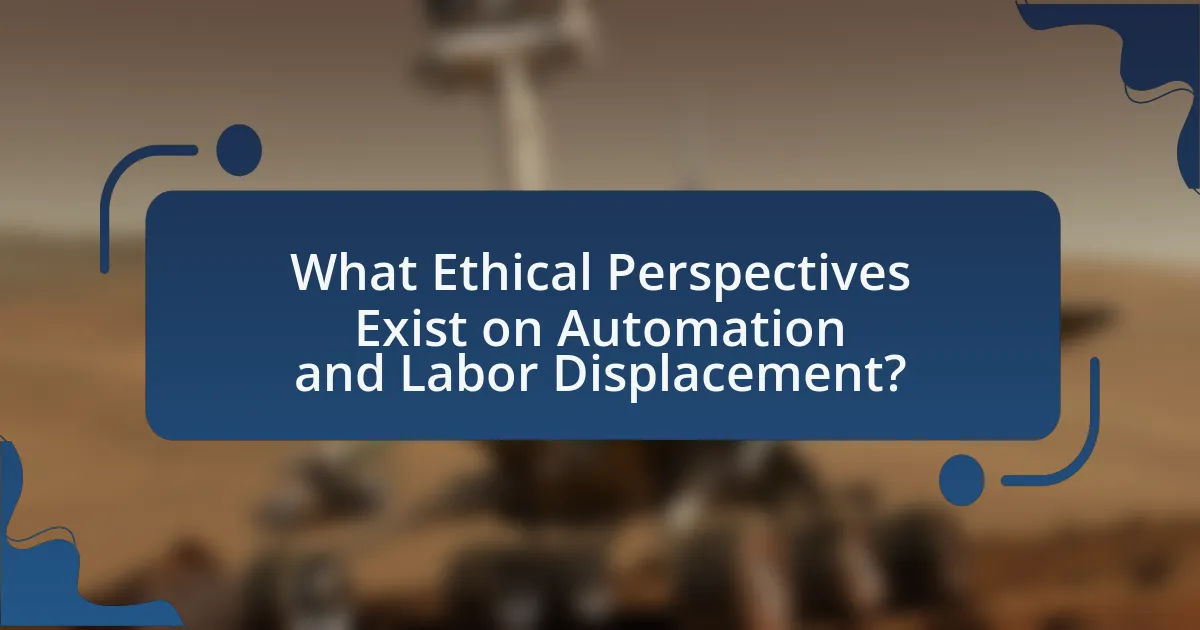
What Ethical Perspectives Exist on Automation and Labor Displacement?
Ethical perspectives on automation and labor displacement primarily include utilitarianism, deontological ethics, and virtue ethics. Utilitarianism evaluates the consequences of automation, arguing that if it leads to greater overall happiness by increasing productivity and reducing costs, it may be justified despite job losses. Deontological ethics focuses on the moral duties and rights of workers, asserting that companies have an obligation to protect jobs and provide fair treatment, regardless of the economic benefits of automation. Virtue ethics emphasizes the character and intentions of those implementing automation, advocating for a responsible approach that considers the well-being of affected workers. These perspectives highlight the complex moral landscape surrounding automation, where economic efficiency must be balanced with social responsibility and ethical obligations to individuals.
How do different ethical theories view labor displacement?
Different ethical theories view labor displacement through distinct lenses, influencing their assessments of its moral implications. Utilitarianism evaluates labor displacement based on the overall happiness or utility it generates; if automation leads to greater efficiency and economic growth that benefits the majority, it may be deemed acceptable despite job losses. Deontological ethics, on the other hand, emphasizes the moral duty to respect individuals’ rights, suggesting that displacing workers without adequate support or consideration for their well-being is inherently wrong. Virtue ethics focuses on the character and intentions behind actions, arguing that a just society should prioritize compassion and support for displaced workers, fostering a culture of care and responsibility. Each theory provides a unique framework for understanding the ethical dimensions of labor displacement, highlighting the complexity of the issue.
What is the utilitarian perspective on automation and job loss?
The utilitarian perspective on automation and job loss emphasizes maximizing overall happiness and minimizing suffering. This viewpoint suggests that while automation may lead to job displacement for some individuals, it can also result in increased efficiency, lower costs, and enhanced productivity, benefiting society as a whole. For instance, a study by the McKinsey Global Institute indicates that automation could increase global productivity by up to 1.4% annually, which can lead to economic growth and potentially create new job opportunities in emerging sectors. Thus, from a utilitarian standpoint, the net benefits of automation, including improved goods and services and economic advancement, may outweigh the negative impacts of job loss for certain individuals.
How does a deontological approach address the rights of displaced workers?
A deontological approach addresses the rights of displaced workers by emphasizing the moral obligation to respect individuals’ rights regardless of the consequences. This ethical framework asserts that workers have inherent rights to fair treatment, job security, and dignity, which must be upheld even in the face of automation and economic shifts. For instance, the Universal Declaration of Human Rights outlines the right to work and to just and favorable conditions of work, reinforcing the idea that displaced workers deserve support and protection. This perspective advocates for policies that prioritize the rights of workers, such as retraining programs and social safety nets, ensuring that their rights are not compromised by technological advancements.
What role do corporations play in addressing labor displacement?
Corporations play a crucial role in addressing labor displacement by implementing retraining programs and fostering job creation in emerging sectors. These initiatives help workers transition from declining industries to new opportunities, thereby mitigating the negative impacts of automation. For instance, companies like Amazon have invested over $700 million in employee training programs to upskill their workforce for technology-driven roles. Additionally, corporations can collaborate with educational institutions to develop curricula that align with future job market needs, ensuring that displaced workers acquire relevant skills. This proactive approach not only supports employees but also enhances corporate sustainability and competitiveness in a rapidly changing economy.
What ethical responsibilities do companies have towards displaced workers?
Companies have ethical responsibilities towards displaced workers that include providing fair severance packages, offering retraining and reskilling opportunities, and ensuring transparent communication about job losses. Fair severance packages help mitigate the financial impact of job loss, while retraining programs enable workers to acquire new skills relevant to the evolving job market. For instance, a study by the McKinsey Global Institute found that up to 375 million workers may need to switch occupational categories due to automation by 2030, highlighting the necessity for companies to invest in employee development. Transparent communication fosters trust and allows workers to prepare for transitions, aligning with ethical business practices.
How can businesses balance automation with employee welfare?
Businesses can balance automation with employee welfare by implementing a hybrid model that integrates technology while prioritizing employee engagement and development. This approach allows companies to enhance efficiency through automation while simultaneously investing in employee training and reskilling programs, ensuring that workers can adapt to new roles created by technological advancements. Research from the World Economic Forum indicates that by 2025, 85 million jobs may be displaced by automation, but 97 million new roles could emerge, emphasizing the need for businesses to prepare their workforce for these changes. By fostering a culture of continuous learning and providing support for employees during transitions, businesses can maintain productivity and employee satisfaction, ultimately leading to a more sustainable work environment.
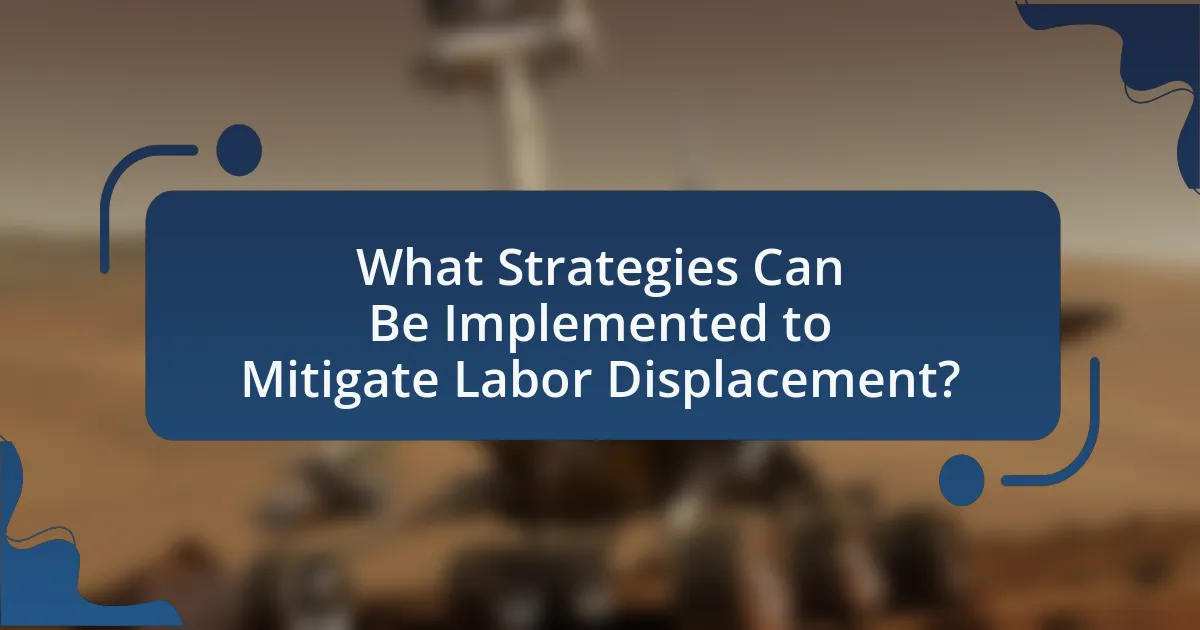
What Strategies Can Be Implemented to Mitigate Labor Displacement?
To mitigate labor displacement, strategies such as reskilling and upskilling workers, implementing social safety nets, and promoting job creation in emerging sectors can be employed. Reskilling and upskilling initiatives equip displaced workers with new skills relevant to evolving job markets, as evidenced by a McKinsey report indicating that up to 375 million workers may need to change occupational categories by 2030 due to automation. Social safety nets, including unemployment benefits and retraining programs, provide financial support during transitions, which can reduce the economic impact of displacement. Additionally, fostering job creation in sectors like renewable energy and technology can absorb displaced workers, with the International Labour Organization projecting that green jobs could create 24 million new positions globally by 2030.
How can education and retraining programs help displaced workers?
Education and retraining programs can significantly assist displaced workers by equipping them with new skills that align with current job market demands. These programs provide targeted training in high-demand fields, such as technology and healthcare, which can lead to increased employability. For instance, a report by the McKinsey Global Institute indicates that up to 375 million workers globally may need to switch occupational categories due to automation, highlighting the necessity for retraining initiatives. Furthermore, studies show that workers who participate in such programs often experience higher wages and job satisfaction, reinforcing the effectiveness of education and retraining in facilitating successful transitions into new employment opportunities.
What types of skills are most valuable in an automated workforce?
The most valuable skills in an automated workforce are technical skills, problem-solving abilities, and interpersonal skills. Technical skills, such as programming, data analysis, and machine learning, enable workers to interact effectively with automated systems. Problem-solving abilities are crucial for adapting to new technologies and addressing challenges that arise from automation. Interpersonal skills, including communication and teamwork, are essential for collaboration in environments where human and automated systems coexist. According to a report by the World Economic Forum, by 2025, 85 million jobs may be displaced by automation, but 97 million new roles could emerge that require these skills, highlighting their increasing importance in the workforce.
How can partnerships between businesses and educational institutions be formed?
Partnerships between businesses and educational institutions can be formed through collaborative initiatives that align mutual goals, such as workforce development and skill enhancement. Businesses can engage with educational institutions by identifying specific skills needed in the labor market and collaborating on curriculum development to ensure that students are equipped with relevant competencies. For instance, companies like IBM have partnered with universities to create programs that focus on technology and data science, directly addressing the skills gap in the workforce. Additionally, internships and co-op programs can be established, allowing students to gain practical experience while providing businesses with a pipeline of talent. These partnerships are often formalized through agreements that outline shared objectives, resource commitments, and evaluation metrics to measure success.
What policies can governments adopt to address labor displacement?
Governments can adopt several policies to address labor displacement, including retraining programs, income support, and job creation initiatives. Retraining programs can help displaced workers acquire new skills relevant to emerging job markets, as evidenced by the success of initiatives like Germany’s “Industry 4.0” training programs, which have effectively reskilled thousands of workers in response to technological changes. Income support measures, such as unemployment benefits or universal basic income, can provide financial stability during transitions, as seen in pilot programs in Finland that demonstrated improved well-being among recipients. Additionally, job creation initiatives, particularly in sectors like renewable energy and technology, can stimulate employment opportunities, supported by data from the International Renewable Energy Agency, which indicates that the renewable energy sector could create millions of jobs globally by 2030.
How can social safety nets support displaced workers?
Social safety nets can support displaced workers by providing financial assistance, retraining programs, and access to healthcare. These measures help mitigate the economic impact of job loss, allowing workers to maintain a basic standard of living while they seek new employment opportunities. For instance, unemployment benefits can replace lost wages, while job training initiatives can equip displaced workers with skills relevant to emerging industries. According to the International Labour Organization, countries with robust social safety nets experience lower rates of poverty and faster economic recovery following labor displacement events.
What role does regulation play in managing automation’s impact on employment?
Regulation plays a crucial role in managing automation’s impact on employment by establishing frameworks that protect workers and promote fair labor practices. Effective regulations can mitigate job displacement caused by automation by encouraging companies to invest in workforce retraining and upskilling programs. For instance, the European Union’s initiatives, such as the Digital Europe Programme, aim to enhance digital skills among workers, thereby reducing the negative effects of automation on employment. Additionally, regulations can incentivize businesses to create new job opportunities in emerging sectors, ensuring that the workforce adapts to technological advancements.
What are best practices for companies to ethically implement automation?
Companies should prioritize transparency, employee involvement, and continuous training when ethically implementing automation. Transparency involves clearly communicating the reasons for automation and its expected impact on jobs, which fosters trust among employees. Involving employees in the automation process allows them to provide input and adapt to changes, ensuring their concerns are addressed. Continuous training equips workers with new skills relevant to the evolving job landscape, reducing the risk of labor displacement. According to a McKinsey report, companies that invest in employee training during automation transitions see a 30% higher retention rate, demonstrating the effectiveness of these practices.
How can companies engage with employees during the automation transition?
Companies can engage with employees during the automation transition by implementing transparent communication strategies and providing opportunities for skill development. Transparent communication helps employees understand the reasons behind automation and its implications for their roles, fostering trust and reducing anxiety. Additionally, offering training programs enables employees to acquire new skills relevant to evolving job requirements, which can enhance their employability and job satisfaction. Research from the World Economic Forum indicates that upskilling initiatives can lead to a 30% increase in employee retention during periods of significant change, demonstrating the effectiveness of these engagement strategies.
What frameworks can guide ethical decision-making in automation?
Several frameworks can guide ethical decision-making in automation, including the Utilitarian Approach, the Rights Approach, and the Justice Approach. The Utilitarian Approach focuses on maximizing overall happiness and minimizing harm, which can help assess the societal impacts of automation. The Rights Approach emphasizes respecting individual rights and freedoms, ensuring that automation does not infringe on workers’ rights. The Justice Approach advocates for fairness and equity, addressing how automation affects different groups, particularly vulnerable populations. These frameworks provide structured methodologies for evaluating the ethical implications of automation, ensuring that decisions consider both individual and societal consequences.
